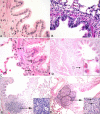Multiple exposures to swine barn air induce lung inflammation and airway hyper-responsiveness
- PMID: 15932644
- PMCID: PMC1164433
- DOI: 10.1186/1465-9921-6-50
Multiple exposures to swine barn air induce lung inflammation and airway hyper-responsiveness
Abstract
Background: Swine farmers repeatedly exposed to the barn air suffer from respiratory diseases. However the mechanisms of lung dysfunction following repeated exposures to the barn air are still largely unknown. Therefore, we tested a hypothesis in a rat model that multiple interrupted exposures to the barn air will cause chronic lung inflammation and decline in lung function.
Methods: Rats were exposed either to swine barn (8 hours/day for either one or five or 20 days) or ambient air. After the exposure periods, airway hyper-responsiveness (AHR) to methacholine (Mch) was measured and rats were euthanized to collect bronchoalveolar lavage fluid (BALF), blood and lung tissues. Barn air was sampled to determine endotoxin levels and microbial load.
Results: The air in the barn used in this study had a very high concentration of endotoxin (15361.75 +/- 7712.16 EU/m3). Rats exposed to barn air for one and five days showed increase in AHR compared to the 20-day exposed and controls. Lungs from the exposed groups were inflamed as indicated by recruitment of neutrophils in all three exposed groups and eosinophils and an increase in numbers of airway epithelial goblet cells in 5- and 20-day exposure groups. Rats exposed to the barn air for one day or 20 days had more total leukocytes in the BALF and 20-day exposed rats had more airway epithelial goblet cells compared to the controls and those subjected to 1 and 5 exposures (P < 0.05). Bronchus-associated lymphoid tissue (BALT) in the lungs of rats exposed for 20 days contained germinal centers and mitotic cells suggesting activation. There were no differences in the airway smooth muscle cell volume or septal macrophage recruitment among the groups.
Conclusion: We conclude that multiple exposures to endotoxin-containing swine barn air induce AHR, increase in mucus-containing airway epithelial cells and lung inflammation. The data also show that prolonged multiple exposures may also induce adaptation in AHR response in the exposed subjects.
Figures







References
-
- Schenker MB, Christiani D, Cormier Y, Dimich-Ward H, Doekes G, Dosman JA. In: Respiratory health hazards in agriculture. Schenker MB, editor. Vol. 158. American Thoracic Society; 1998. pp. S1–S76.
-
- Asmar S, Pickrell JA, Oehme FW. Pulmonary diseases caused by airborne contaminants in swine confinement buildings. Vet Hum Toxicol. 2001;43:48–53. - PubMed
-
- Zejda JE, Barber EM, Dosman JA, Olenchock SA, McDuffie HH, Rhodes CS, Hurst TS. Respiratory health status in swine producers relates to endotoxin exposure in the presence of low dust levels. J Occup Med. 1994;36:49–56. - PubMed
-
- Zejda JE, Hurst TS, Rhodes CS, Barber EM, McDuffie HH, Dosman JA. Respiratory health of swine producers: Focus on young workers. Chest. 1993;103:702–709. - PubMed
-
- Frevert CW, Warner AE. Respiratory distress resulting from acute lung injury in the veterinary patient. J Vet Int Med. 1999;6:154–165. - PubMed
Publication types
MeSH terms
Substances
LinkOut - more resources
Full Text Sources
Medical

